

Greetings from the Pocket Concierge Editorial! Japan is famous for its many seasonal tastes, but perhaps none are as unique as ‘Crab’. While the crustacean has a variety of specimen each enjoyed during specific times of the year, the consecutive and subsequent nature of these specimens’ seasons makes for a seafood to be enjoyed at any time of the year. For example, Snow Crab is a delicacy enjoyed widely from autumn to winter, whilst Japanese Blue Crab and Horsehair Crab are popular for the duration of the remainder. Another sought-after breed is the Shanghai Hairy Crab, available from October through December at many a Chinese restaurant. In this article, in hopes of learning more about the delicious varieties of seasonal crab, we asked two crab-cooking professionals about the charms of our favorite Japanese and Shanghainese specimen.
1.[Interview] Daikanyama Sansho Chef Yasunori Ishida 〜Japanese Crab; Four Seasons, Countless Flavors〜
2.[Interview] Renge Chef Hidetoshi Nishioka 〜Shanghai Hairy Crab Season; the Hows and Whys of a Delicacy〜
3.Popular Restaurants to Enjoy a Variety of Japanese Crabs
4.Popular Restaurants to Enjoy Shanghai Hairy Crabs
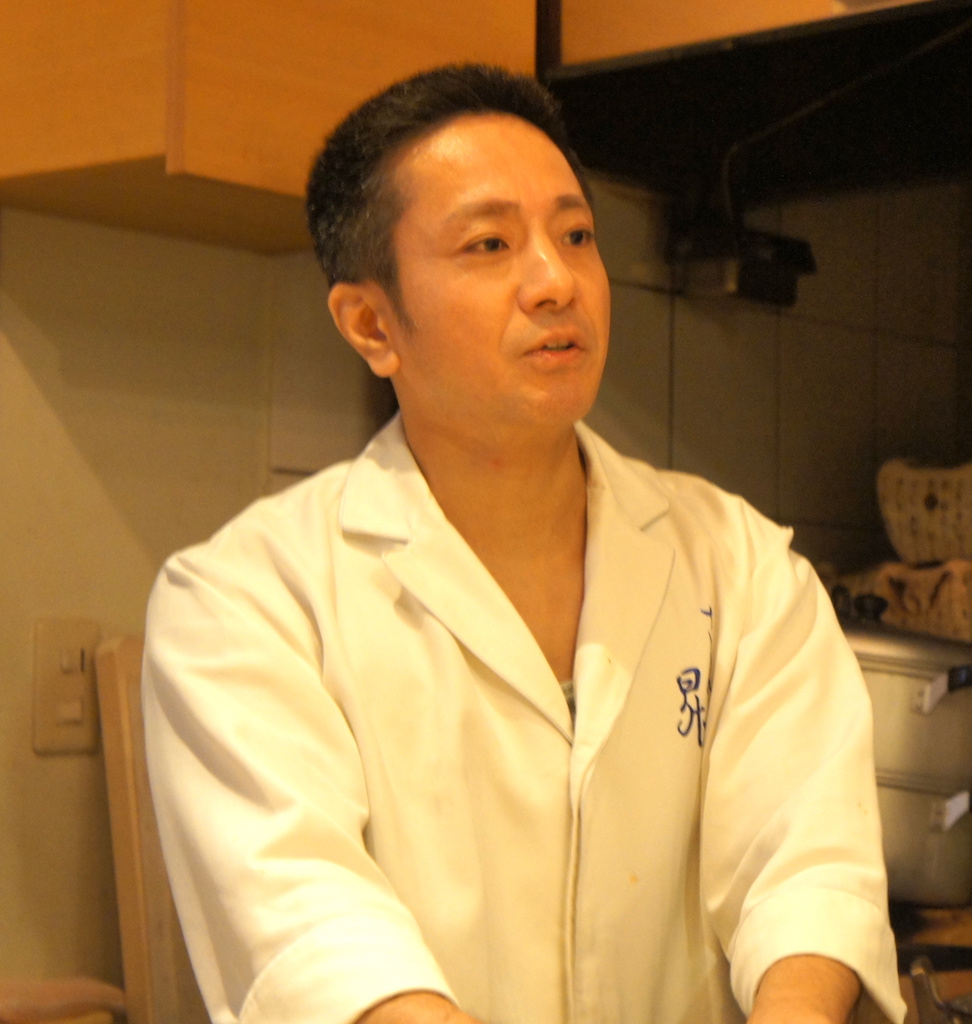
Daikanyama Sansho Chef Yasunori Ishida: Trained in Japanese cuisine at restaurants in Tokyo and Kyoto before opening Sansho in 2012. Offers a transient feel of the seasons in a course of fresh ingredients flown directly from their sources all over Japan, including the chef’s native Tottori.
What are the different varieties of edible Japanese crab?
Of saltwater varieties, the most famous are the Snow (‘Zuwai-gani’), Horsehair (‘Ke-gani’), and Japanese Blue Crab (‘Watari-gani’). The most well-eaten freshwater variety is the Japanese Mitten Crab (‘Mokuzu-gani’), a sibling of the Chinese Mitten (Shanghai Hairy) Crab. One of Japan’s favorites, the Red King Crab (‘Taraba-gani’), is commonly misunderstood to be a relative as well; in fact, the Red King has only 8 legs to a crab’s 10, as it is in actuality a very large brother of the hermit crab. Furthermore, much of the Red King Crab enjoyed in Japan is imported, with much coming from neighboring Russia.
Regarding the Snow Crab, people may know of it by any number of names; locals call it each in their own way, and branding too can add to the confusion. For example, the northwestern ‘hokuriku’ region calls the crab ‘Echizen’ Crab, whilst the southwest ‘san’in’ region calls it the ‘Matuba’ Crab. In Kyoto Snow Crab is known as ‘Taiza’ Crab, and in Hyogo prefecture ‘Tsuiyama’ Crab. Occasionally, the label ‘Hon (true) -Zuwai’ Crab as to the normal ‘Zuwai’ is applied to Snow Crab caught in the Sea of Japan, further complicating the equation. This owes to the popular sentiment that while Snow Crab is native to Russia and Canada as well, those from the Sea of Japan are the most delicate and rich in taste.
Tottori prefecture, one of the ‘san’in’ states, has further sub-varieties of Snow Crab. Beyond calling the normal Snow Crab (‘Zuwai-gani’), inhabitants of the sea 200-400 meters deep, ‘Matsuba-gani’, the region calls the same specimen living further in the depths, between 500-2700 meters, ‘Aka-zuwai-gani’ (‘Red’ Snow Crab). The title comes from the color of the crab’s shell; where normal snow crab tend to have a purple-ish hue, its ‘red’ sibling is colored a more vibrant crimson. Finally, there is also an extremely rare ‘Ougon-gani’ (‘Golden’ Crab), caught perhaps 1-in-7000 to every normal Snow Crab; it looks like the normal Snow Crab, but tastes like the ‘Red’ version, as it is the result of a mixed marriage between the two brethren.
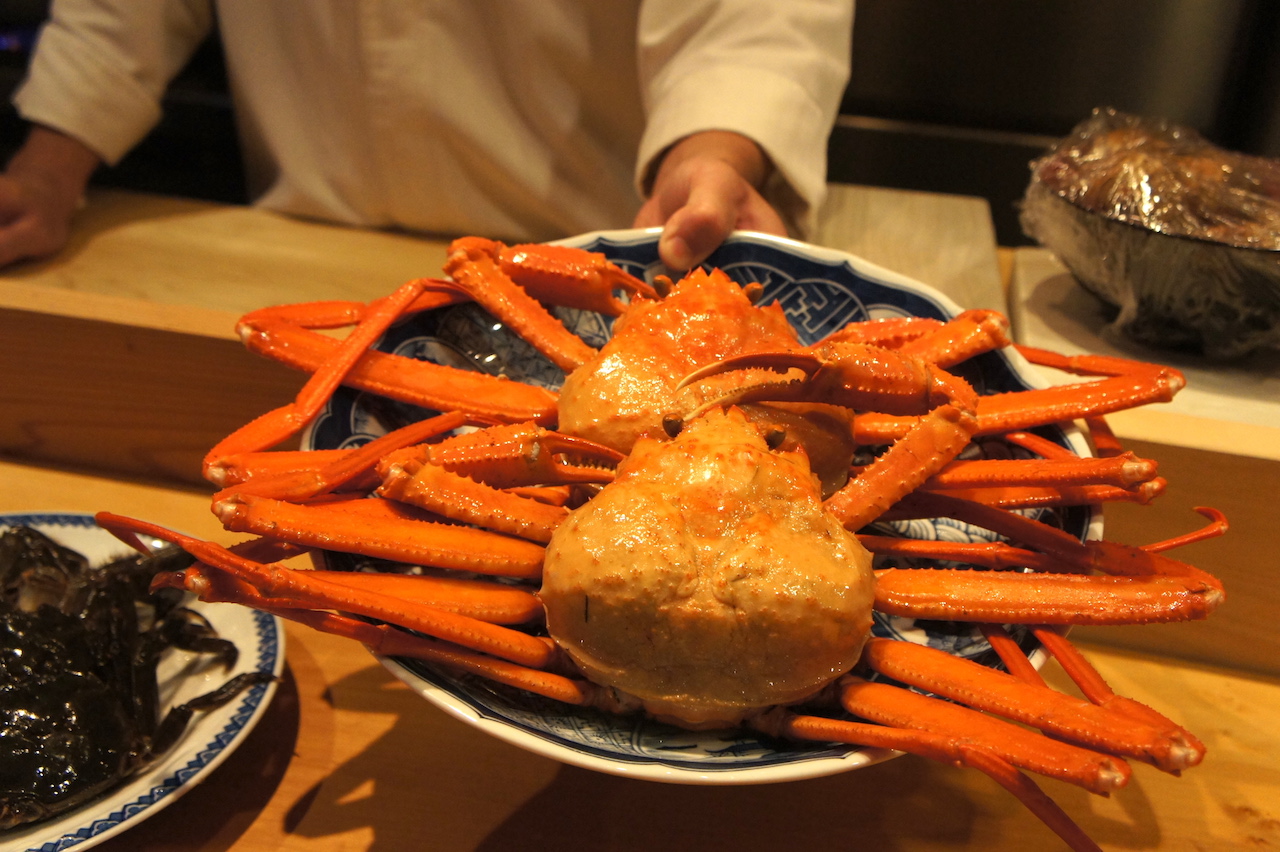
Tottori-prefecture ‘Aka-zuwai-gani’ (boiled): the crab is caught only in the Sea of Japan, and Tottori is its most significant source.
To add one last touch, everything I just mentioned is regards to the male of the Snow Crab family; the ladies are, depending on the location, called ‘Seiko-gani’ or ‘Koubako-gani’
When are each of the crabs in season?
The ‘season’ of a particular specimen is mostly dependent on the periods for which fishing is permitted. With this in mind, ‘Matsuba’ Snow Crab fishing season begins on the 6th of November, and ends the 20th of March the next year. Its deep-dwelling relatives ‘Aka-zuwai-gani’ are fishable 10 months of the year, with a ban in place only during July-August, but only in the cold winter months can they be delivered live and fresh to restaurants afar; being accustomed to cold environments by nature, they tend to go bad quickly during warmer periods. Hence as far as Tokyo goes, ‘Red’ Snow Crab season is best stated as winter. To add on, the female varieties of ‘Red’ Snow and Horsehair Crabs are banned from fishing for environmental protection reasons, and the fishing of female Snow Crab, although allowed, is subject to a shortened fishing season (November 6th - End of Year). Speaking of rare delicacies, crab shed their skin every-so-often; from the end of January through February, ‘Waka-matsuba-gani’ (Or ‘Zubo-gani’ in the case of northern ‘Echizen-gani’), male Snow Crab boasting a new shell, can be had, adding to the seasonal joys of the crab family.
Outside of Snow Crab, Horsehair Crab is available year-round from Hokkaido, from the northeastern Okhotsk Sea during spring, and from the southwest-side Uchiura Bay after summer. Horsehair Crab tend to be shipped post-‘hama-yude’, a process where fresh-caught crab is boiled en-masse in a large pot; as this involves a large amount of simultaneous crustacean-boiling, the crab to-be-shipped absorbs the flavor-rich extractions in the water, and is enhanced by the time it is done cooking. Japanese Blue Crab too is available throughout the year; thanks to its being native to seas across Japan, there is at least one source in season at any given time of year. Of these seasonal sources of Blue Crab, Kesen-numa, of Miyagi prefecture, is especially renowned for its quality. Finally, Japanese Mitten Crab has a relatively short season, from late August to October; at Sansho, we procure from Shimane-prefecture’s Lake Shiji, famous for its freshwater seafood.
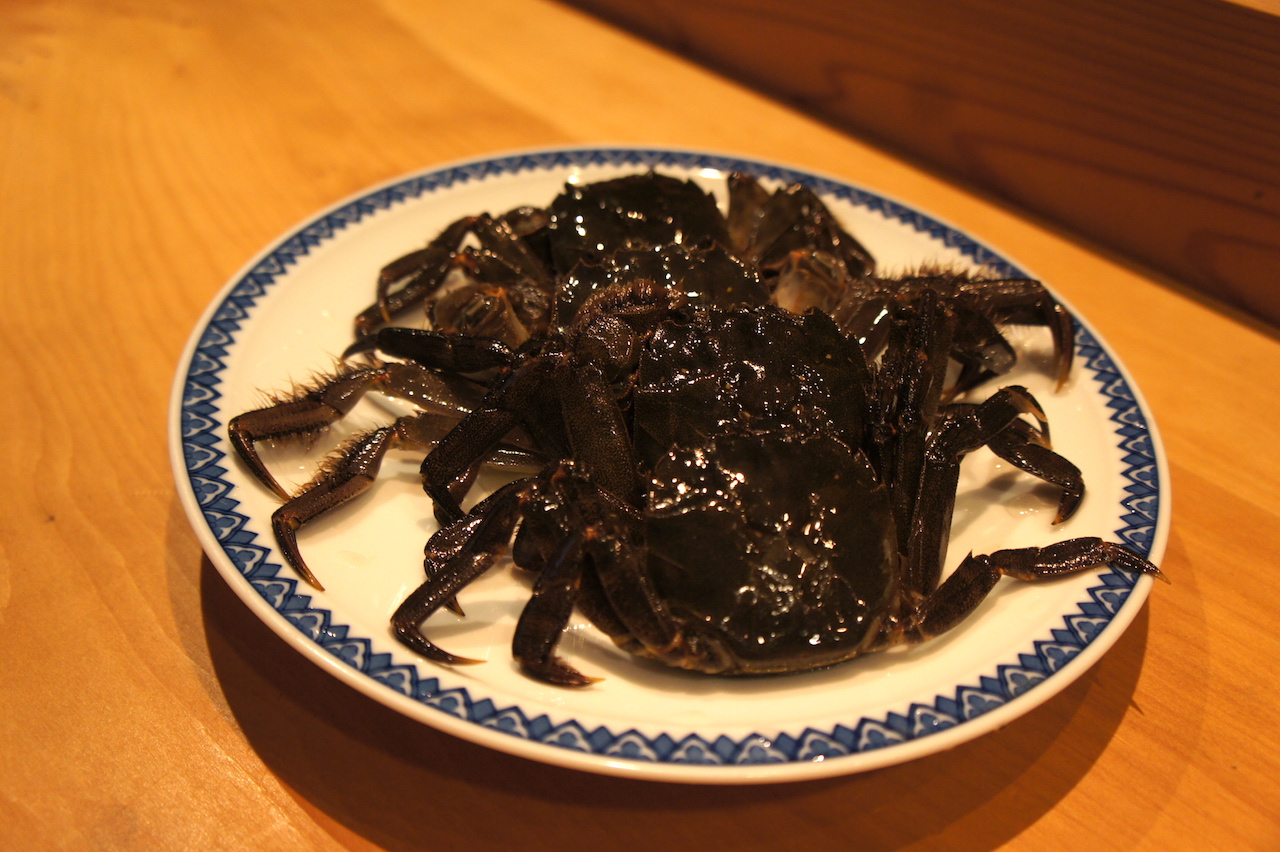
Tottori-prefecture Japanese Mitten Crab: Females have an enlarged belly ‘fundoshi’ triangular section, while males have a smaller ‘fundoshi’ but a larger pincer
How do you differentiate the best crab from the rest?
As far as Snow Crab goes, the domestic species and its Russian or Canadian brethren have several physical contrasts. While the Japanese Snow Crab have a straight upper lip, its international siblings have a lip shaped like the letter ‘M’. Foreign Snow Crab also tend to have slightly shorter legs, another tell-tale sign.
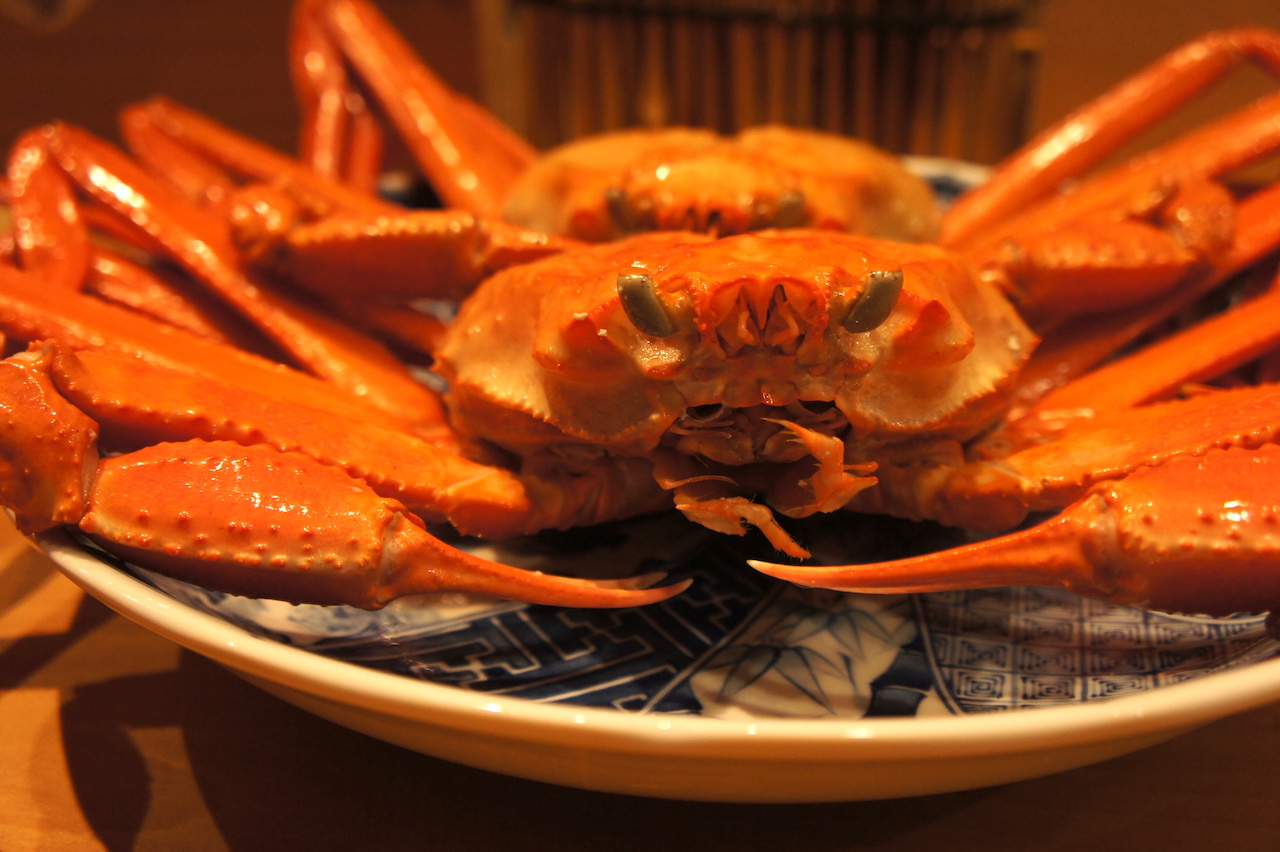
Above: Domestic Snow Crab breeds have straight upper lips
Another way to tell the best Snow Crab apart is to look for those that are ‘tagged’; as only those meeting a certain standard are shipped with these tags, selecting these all but guarantees a good pick. The criteria to receive a tag differs along with the source, but for example, with san’in region ‘Matsuba-gani’, only live-caught males with a shell diameter of over 11 centimeters, weight of 400 grams, and 5 pairs of legs can be shipped with the merit-ful tags. The reason a total of 10 even legs, something ordinary for the crab, is set as a measure for excellence, is because the crustacean has a tendency to self-amputate when under stress; with brand-name excellence involved, tag-worthy ‘Matsuba-gani’ was decreed to be only those with a full 5 pairs.
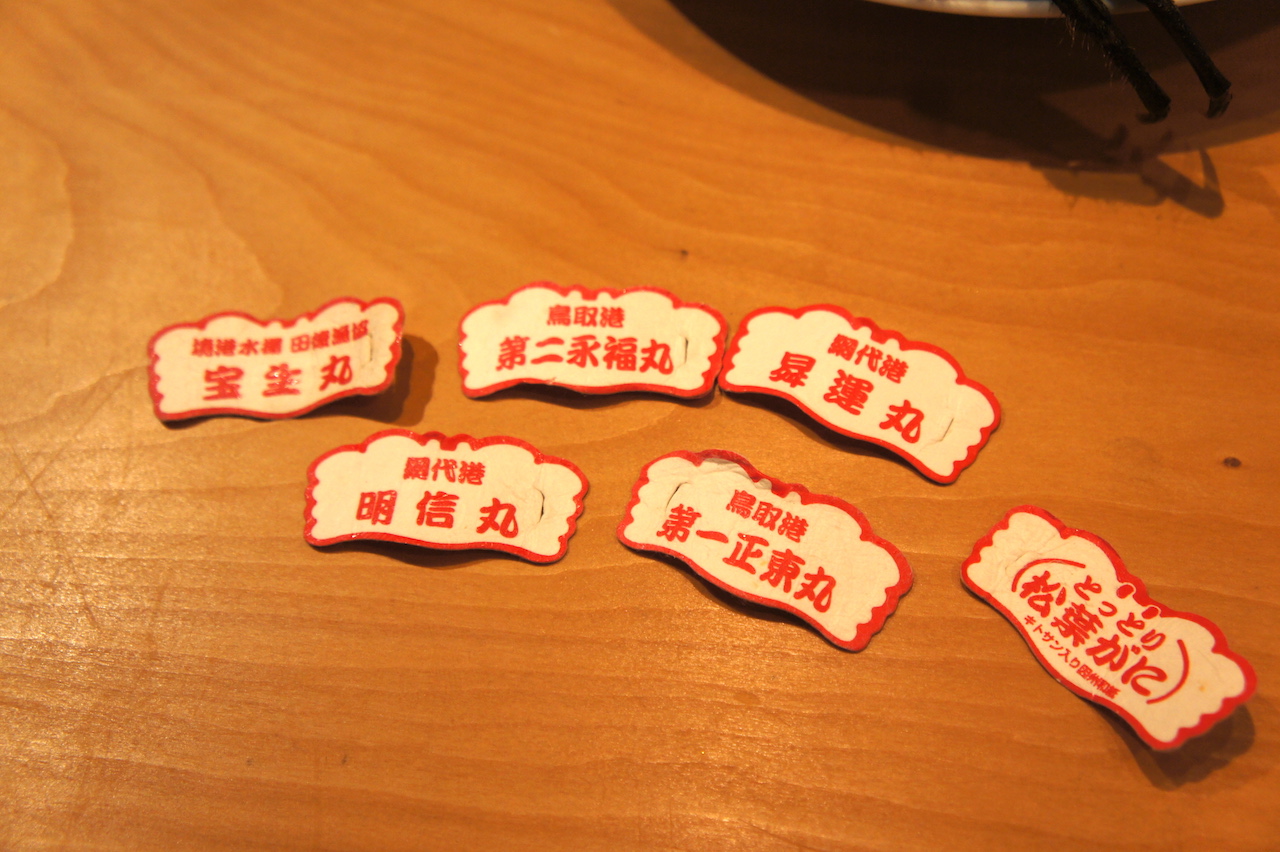
Above: Tottori-prefecture ‘Matusuba-gani’ tags; made with Tottori’s regional craft ‘Inshu-washi’ Japanese paper instead of plastics, the inclusion of chitosan ensures it is water-resilient as well. While only male ‘Matsuba-gani’ can be tagged, other regions will place tags on female Snow Crabs as well
Lastly, please share with us how you prepare your famed crab dishes
If I have live crab in store, I first have my guests start with crab sashimi, serving a portion of the leg raw. After that everything is cooked; speaking honestly, crab is almost always more tasteful prepared. First up is shabu-shabu, lightly boiling leg cuts rare; following up is grilled crab, complete with rich crab butter. The one exception is with ‘Waka-matsuba-gani’, male san’in Snow Crab with a new post-shed shell; as grilling ruins the delicate meat, this specimen I exclusively serve raw.
Besides crab, I serve dishes combining ingredients that share the season with my centerpiece crustacean; from autumn matsutake mushrooms to winter tiger blowfish, I infuse the best of the season’s fruits for the enjoyment of my guests.
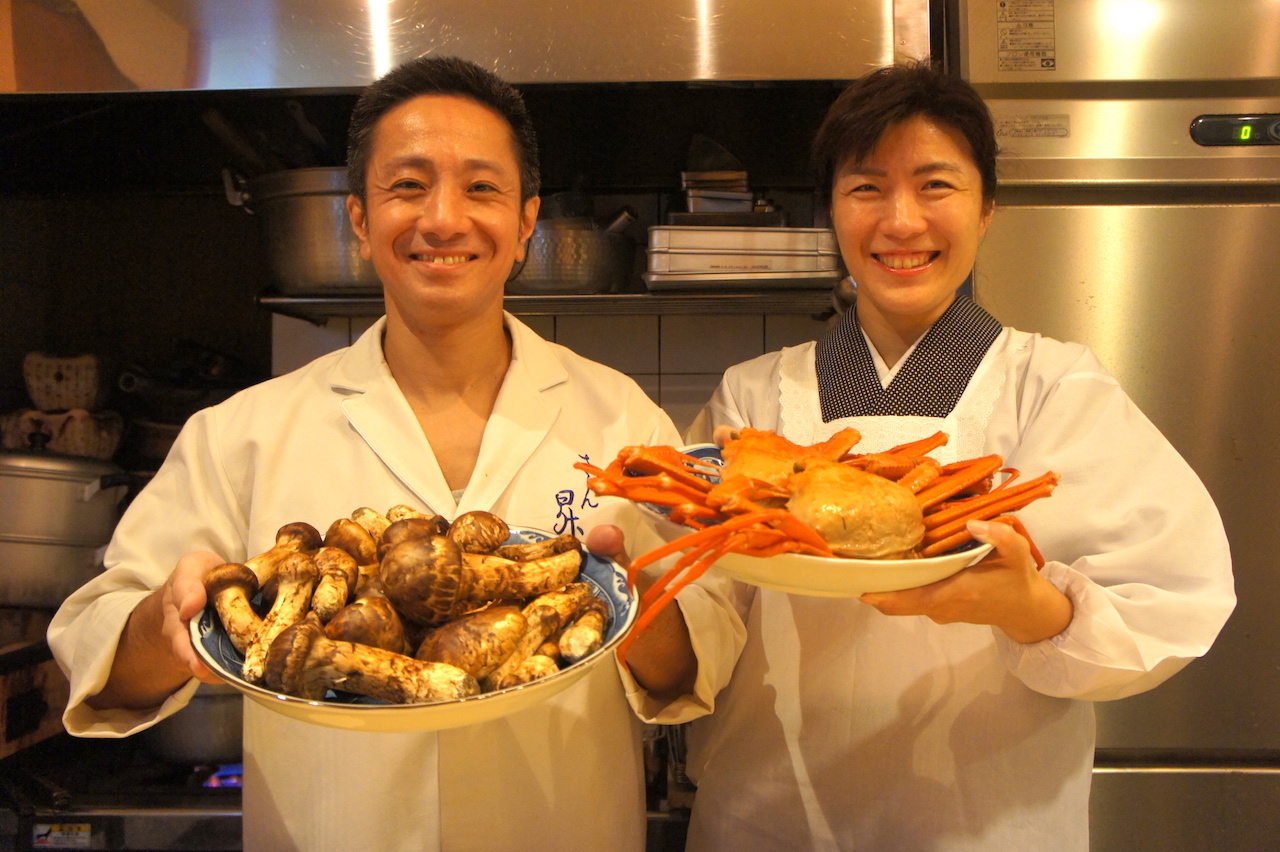
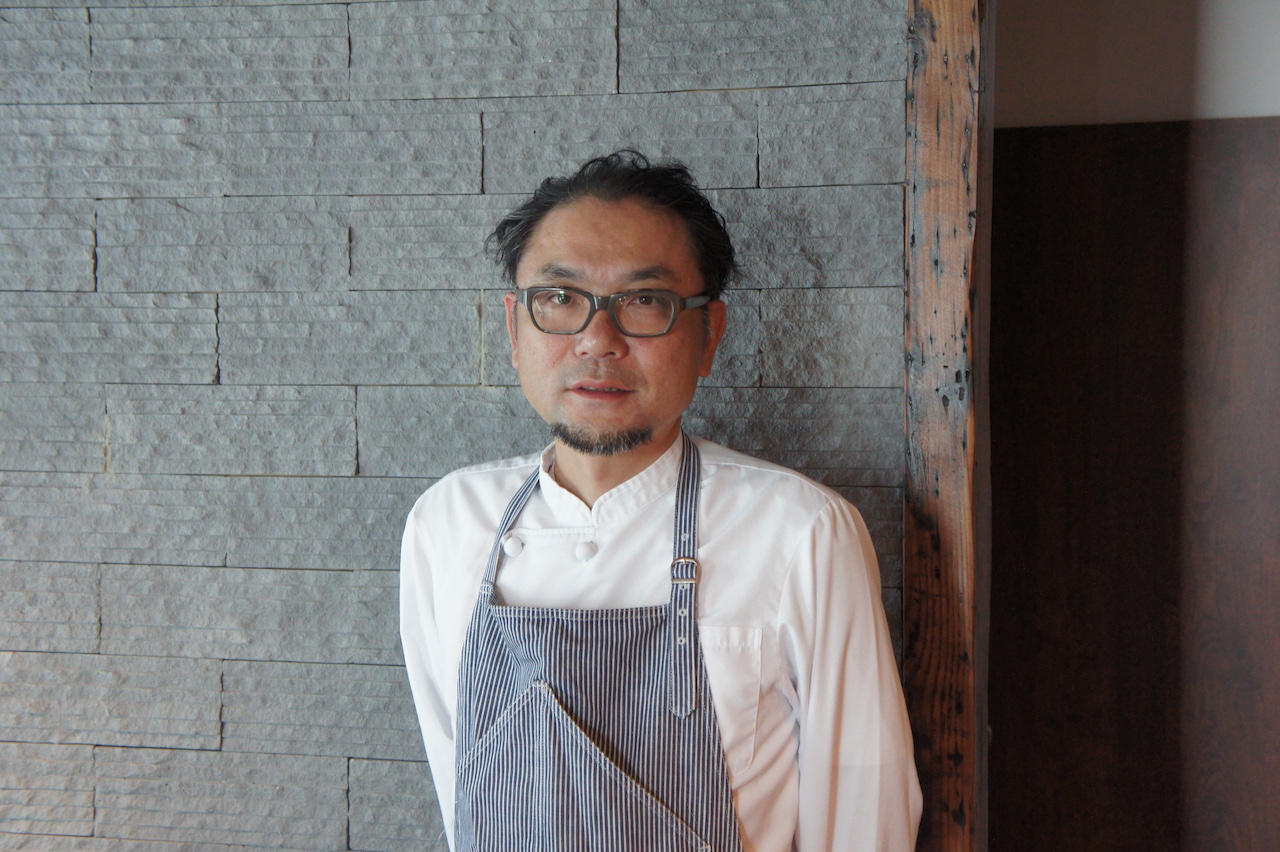
Renge Equriosity Chef Hidetoshi Nishioka: Trained at esteemed Shanghainese restaurant CHEF’S, then in Spanish and Italian cuisines as well as at a Japanese restaurant in New Zealand before turning to consulting restaurateurs. Opened Chinese Tapas Renge in 2009 in Shinjuku to success, and moved and changed names to the current Ginza Renge Equirosity in 2015. Has gained widespread acclaim for a unique take on Chinese cuisine making use of his broad culinary learnings.
Shanghai Hairy Crab has quite many sources; where do you often procure from?
Authentic Chinese Shanghai Hairy Crab, or Chinese Mitten Crab, is mostly sourced from freshwater lakes by the Yangtze River. The most famous origins of this delicacy are the Lakes of Yangcheng and Taihu, near Suzhou and neighboring the city of Shanghai. At Renge Equriosity, we for the past few years have sourced crab from lakes in the more inland Anhui province, having moved slightly west out of the more recognized coastal lakes along the Yangtze. Also, while Shanghai Hairy Crab mate and release their offspring in estuaries of brackish water, and hence they cannot completely be farm bred, from a hygiene perspective, the crab we source is semi-farmed. However, as the breed is well-known for being enduring, we import all of our Shanghai Crab fresh and live, in order to create the finest dishes possible out of this delicacy.
When is Shanghai Hairy Crab best eaten?
Crustaceans in general are reliant on the lunar cycle in terms of stages of life; therefore, it is rather accurate to say that there is a set date every year when the season begins and ends; speaking broadly, female Shanghai Hairy Crab is most flavorful in October, and their male partners are best in November. I am unsure if any restaurant is detail-oriented enough to actually separate the sexes, but I do believe those who prefer steamed Shanghai Crab tend to prefer the male breed. Also, from personal experience, I would recommend the second week of October through December as the best period; the crab butter contained within is richest during those weeks.
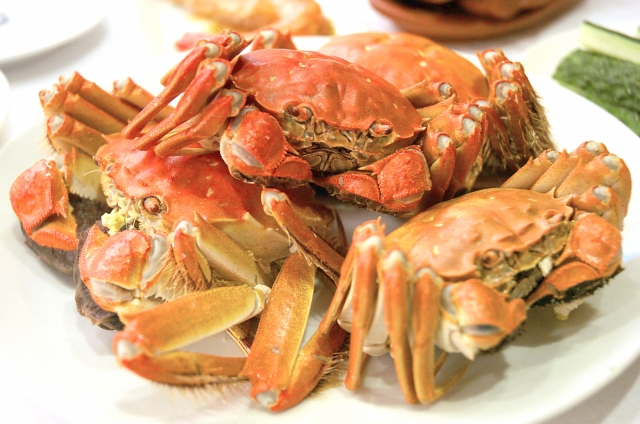
Product image for illustration purposes only.
What exactly is the difference between the male and female of Shanghai Hairy Crabs?
This is true of most other freshwater dwellers as well, but their flavors are heavily dependent on the quality of water they are grown in. Taking Japanese cuisine as an example, connoisseurs of freshwater delicacies like sweetfish and eel commonly point to specific rivers as profoundly good sources. Shanghai Hairy Crab is the same; the quality of its birth-lake dictates the goodness of its taste. But beyond generalities, the difference of male and female lies mostly in the crab butter; to be specific, in whether they host roe or milt. Shanghai Hairy Crab is rather small as far as edible crabs go, and the timeless allure that makes it such a revered delicacy lies in the rich flavorful-ness of its juice; the eggs have a chewy thickness, and the milt a lavish melt-in-your-mouth silkiness that captivates an international following.
How is, or do you, weave Shanghai Hairy Crab into your menu?
The basic how-tos are steaming, stir-frying, or marinating in ‘Shaoxingju’, a Chinese rice wine; as mainland China has an abundance of the species, chefs can afford to get creative, from taking just the crab butter and stir-frying with eggs, or just the legs to cook with greens, or just taking whatever else to create dishes a la carte. At Renge Equriosity, we keep away from plain steaming unless expressly requested by a guest; it is simply too much of a hassle to eat. Instead, we lean towards making Shanghai Hairy Crab into something entirely anew, while still keeping it as the hallmark of the dish. Our menu features creative treats like ‘Shanghai Crab Bisque’, ‘Shanghai Crab Xiao-Mai’, and ‘‘Golden’ Mapo-Tofu with Shanghai Crab Butter’ featured throughout the course. Hopefully, guests enjoy the luxurious sensory pleasures available only for the October-December season; we are always welcome to new visitors, and look forward to receiving you at Renge.
~The fruits of Tottori, in full bloom in Tokyo; enjoy the otherworldly flavors of ‘tagged’ brand ‘Matsuba’ Snow Crab~
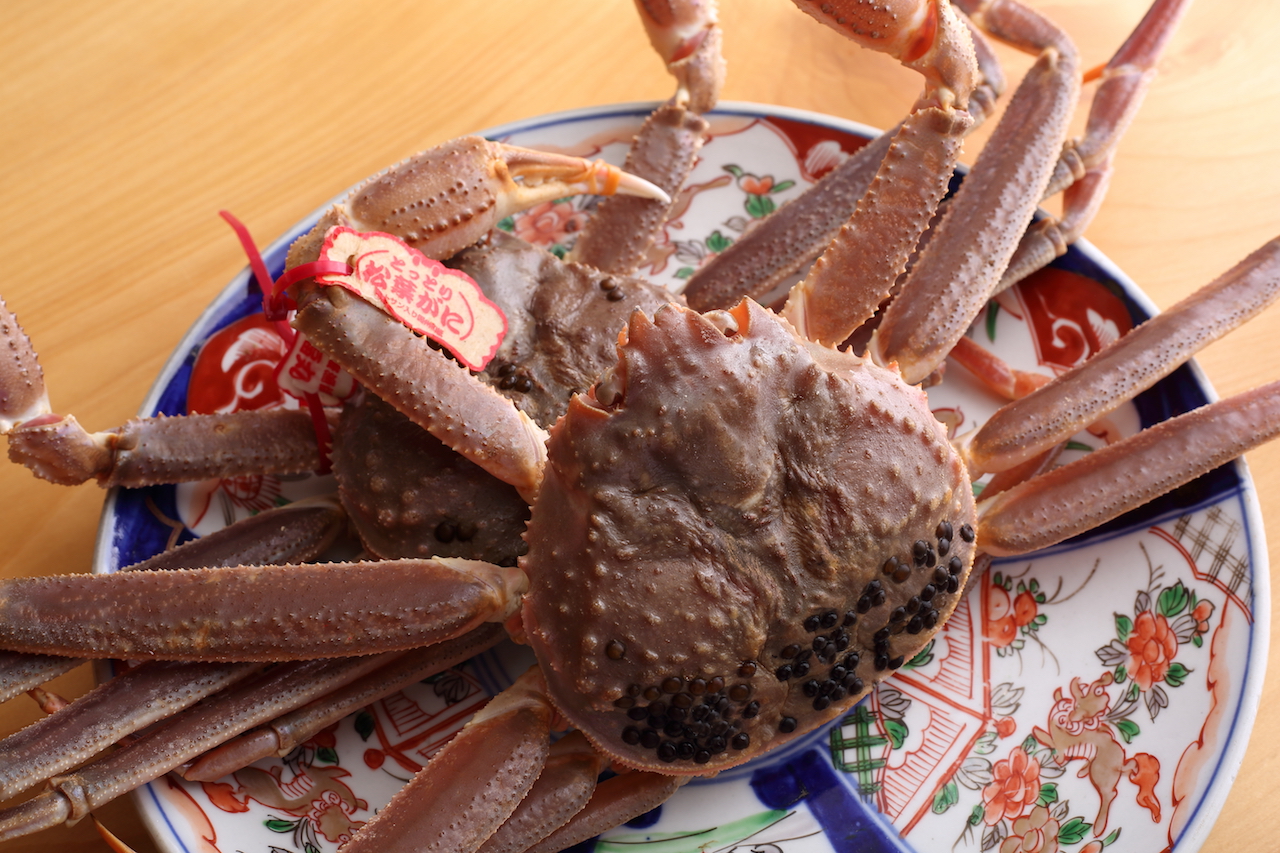
Daikanyama Sansho boasts straight-from-the-source ingredients flown from across the Japanese isles transformed into beautiful seasonal sensations. At the hands of chef Yasunori Ishida, foods from his native Tottori and others, and winter specialty ‘Matsuba-gani’ brand Snow Crab turn into unforgettable memories. Sourcing exclusively ‘tagged’ premium live crab, Sansho prepares each dish straight from the aquarium for an exquisite balance of sweet and rich flavor. With a lineup including ‘Red’ Snow, Blue, and Horsehair Crabs as well, guests are sure to be absorbed by this haven for crustacean lovers instantly. Notable too is the humbling family operation and a cozy home-like atmosphere; enjoy every season’s catch of the day anytime, in the middle of Tokyo.
~Let your senses roam free; an atmospheric ‘sukiya’ tea room-style interior and the season’s finest in Japanese cuisine~

Famous gourmet guide 1-star Chisou Nakamura sets a high bar, holding as principle a perfectly balanced course where all layers are harmonic, with none standing too far beyond, but in total achieving an extraordinary height. From November 7th til the end of February, Nakamura serves ‘Echizen’ Snow Crab from up north; during the autumn matsutake mushroom season, don’t miss the matsutake-snow crab duet. Through the end of the year, chef Akira Nakamura sources rare female ‘Echizen’ Crab for unique stuffed crab-shell creations. With every plate, guests are invited to an incredible sensory world where all 5 senses are blessed with the season’s pleasures. Past the new year, the chef is open to guest requests; from grills and sashimi to mixed rice dishes on seasonal tableware, enjoy the master’s skill and hospitality in a tea room ‘sukiya’-style hall of classic elegance for a truly ‘Japanese’ culinary experience.
~A Famous gourmet guide 2-star wonderland; lavish in an overwhelming seasonal haute-cuisine experience~
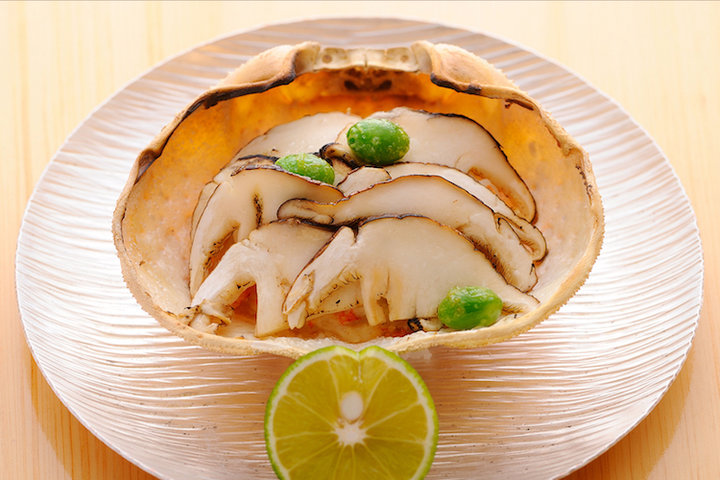
“Unforgettable dishes” “Every guest leaving in delight”; Owner chef Toshiya Kadowaki of the 2-star Azabu Kadowaki holds himself and his seasonal creations to nothing less than superb. Using the finest of Japan’s natural bounties and the world’s exquisite fruits, the chef originates a unique Japanese cuisine like no other. From November 10th to March, this includes ‘Matsuba’ Snow Crab, alongside fried shark-fin and black and white truffles, culminating in the specialite ‘Truffle Mixed Rice’. Visit once, but beware; a return trip will already be in the works.
~Taste the four seasons of Kanagawa; pure Japanese hospitality, and a memorable culinary evening~

Nihon Ryori Zeniya, a recipient of 2 Famous gourmet guide stars, provides extraordinary creations using the finest of natural chef’s haven Kanazawa’s seasons. The 2nd generation master, Shinichiro Takagi, returned to his origin after honing his craft at the revered Kyoto Kiccho. He and his younger brother Jiro, the current head chef, run Zeniya in a cooperative effort. Their menu features Snow Crab from November 7th through January, with an occasional ‘Koubako-gani’, the rare female Snow Crab, arriving to guests’ delight towards the end of the year. From grilled and steamed to mixed in rice, Zeniya’s kitchen serves guests an ad hoc course of dishes reflecting their preferences and even the day’s weather. When in town, make sure to place a booking, for an unforgettable taste of Kanazawa’s natural bounties.
~A globalist chef produces extraordinary Japanese cuisine creations~

In Hakata’s bustling downtown, Nihon Ryori Nagaoka owner-chef Shugo Nagaoka, formerly also of the gastronomy non-profit Slow Food Nippon, spins his magic. Aspiring to create “dishes that convey the hopes and smiles of producers”, utilizing ingredients from his native Hagi, Yamaguchi alongside surrounding Kyushu’s natural bounties, the chef weaves dishes that are as simple as they are sumptuous. From September to October, Nagaoka sources Mitten and Blue Crab; during October, Snow Crab; past November, chef Nagaoka uses Red King and ‘Matsuba’ Snow Crab in a myriad of courses including soups, charcoal grills, steamed dishes, and shabu-shabu. The restaurant is comfortable serving in English as well, allowing international guests some breathing room; for those traveling long hoping to taste Japan’s seasons and authentic culinary delights, definitely search for this hospitable Hakata den.
~Fun from down-under; Hakata-style Japanese cuisine and smile-invoking charming hospitality~
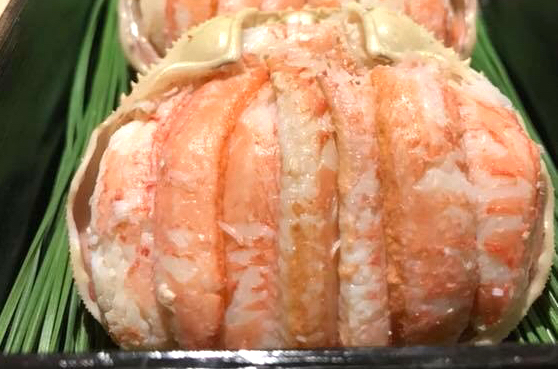
Shirogane Nishida is driven by the concept “Serving delicious food is a given; making a destination that is fun-inspiring and exciting is critical”. Owner-chef Shingo Nishida’s ideal is apparent at every corner of this establishment; the counter seating is designed at the same level as the kitchen counter in order to facilitate conversation. Nishida’s dishes feature a blend of seasonal and Japanese cultural essences, of which crab is a centerpiece during the November-March season; from November 20th, the chef’s haute courses feature ‘Matsuba’ Snow Crab both raw and boiled in Crab butter-broth, as well crab-butter stew, a flavor laden sensation sure to rouse. For special dates, anniversaries, receptions, and more, visit this gourmet outpost that keeps a revolving door of regulars from afar coming.
~Classic Japanese dishes with the characteristic Fukuoka and culture~
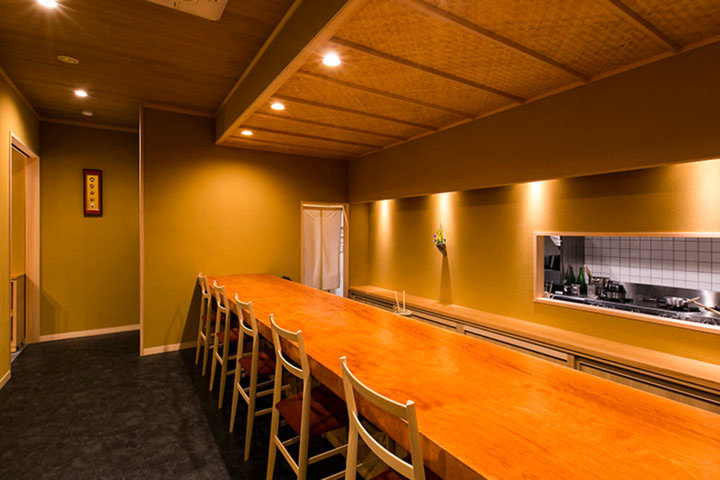
Owner-chef Makoto Furukawa, a veteran of Osaka establishment Aji-Kiccho among others, concocts an authentic ‘kaiseki’-style Japanese cuisine infused with the hopes and efforts of Kyushu’s producers and craftsmen. His courses include rare ‘Red’ Snow Crab between November and December, and ‘Matsuba’ Snow Crab in all courses over 15000JPY. Bask in mature and exquisite Japanese hospitality and let your thoughts wander among the cultures of Japan’s locale as you enjoy an unforgettable dining experience.
~Delicious Hokkaido ingredients charm you in a modern-style blend of Japanese and Western cuisine~
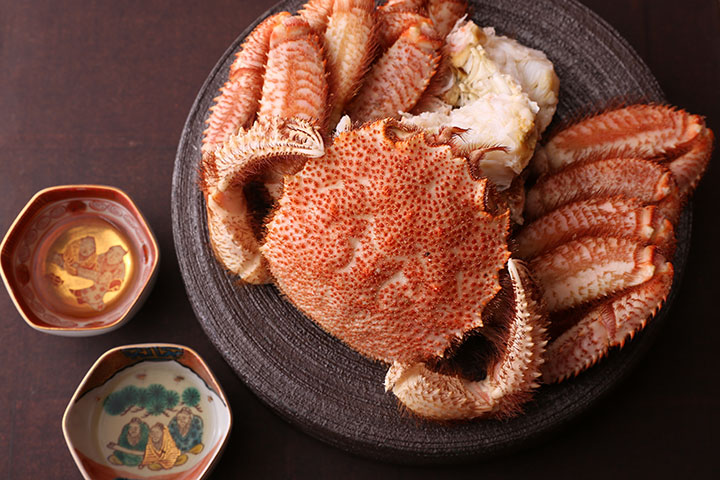
In particular, "Ginza Shibutani" focus on ingredients from Hokkaido, using the own special routes to purchase fresh seafood and vegetables directly from the production areas, and all cooked by the chef, Hokkaido native Yuichi Maruko. Hokkaido’s unique and always exquisitely delicious ingredients change with the seasons, such as the Hairy crab, King crab, Snow crab, sea urchins, Tokachi wagyu beef, and Shiretoko wagyu beef. That's a variety of other elaborate dishes that appeal even to gourmet guests.
~Thinking-outside-the-box; a one-of-a-kind Shanghainese cuisine for the ages~
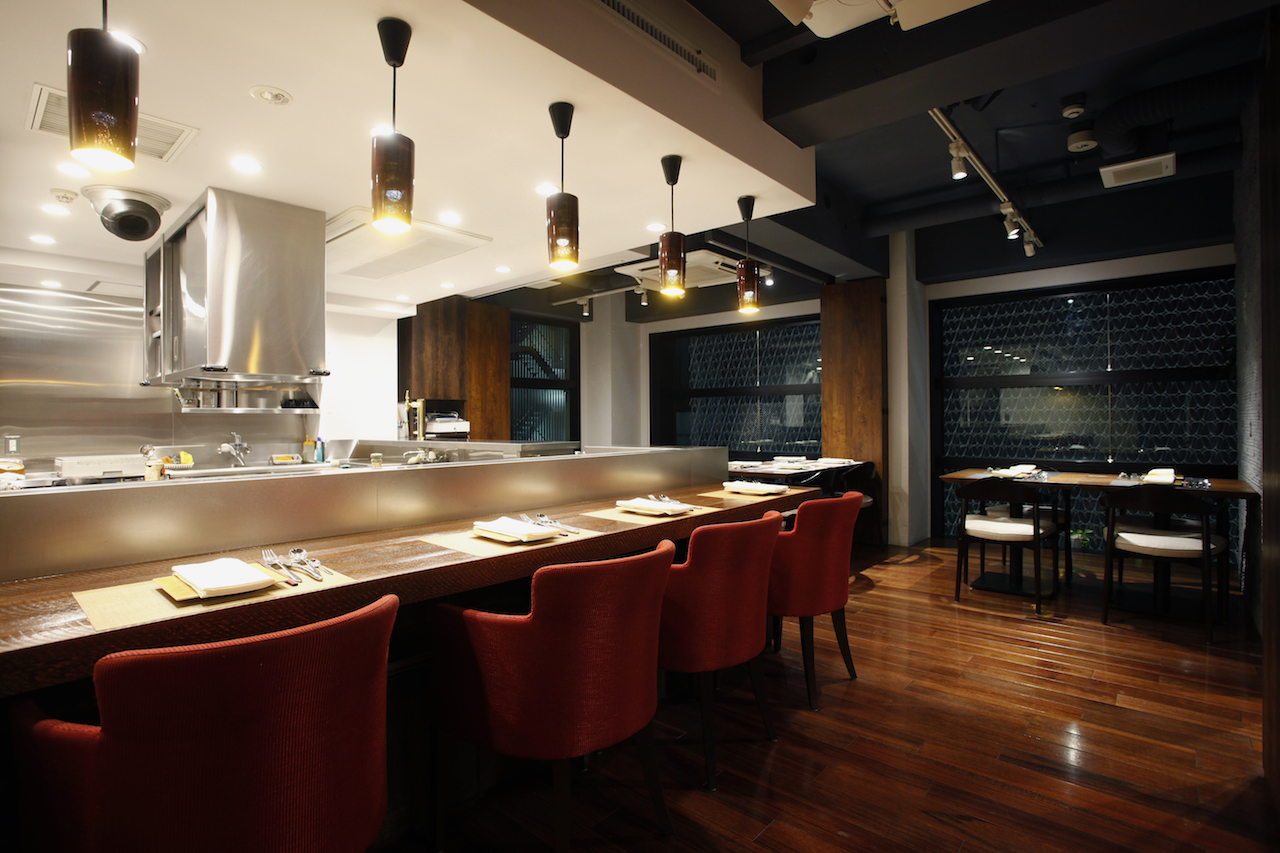
Enjoy a unique Shanghainese menu infused with essences from both Japanese and European cuisine. Renge Equriosity offers Shanghai Hairy Crab in a myriad original ways, alongside classic Chinese dishes with twists you have never seen. The warm modern interior is perfect for dates, families, and receptions, with a semi-private room for those who prefer some quiet. For a mature and wonderous dining experience, do try this magnificent restaurant out.
~The Essences of Sichuan Cuisine, Learnt from a Hallowed Hall~
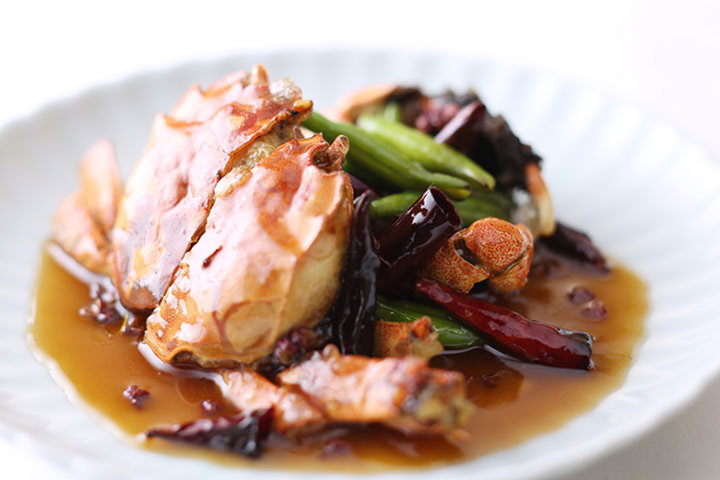
Leading Shu Xiang-Xiang is owner-chef Hirotsugu Kikushima, formerly the longtime head chef at the famed Chinese restaurant Choyo. Serving a Sichuan-based course of selected fine ingredients and spectacular originality, his kitchen of proven strength presents the essences of China’s southern lands. Sourcing from the best there is, chef Kikushima’s Yang-Cheng Lake-born Shanghai Hairy Crabs are available only from November through the end of the year; arriving steaming marinated in rice-spirits, stewed with shark-fin, or stir-fried with peppers, enjoy a unique mariage of Sichuan with Shanghai at this remarkable dining destination. For excellent Chinese cuisine alongside warm hospitality befitting the hall’s small scale, visitors are almost guaranteed to want to be back soon.
~New-Style Chinese Cuisine; Exquisite Delicacies and Drink Pairings at an Elegant Counter~
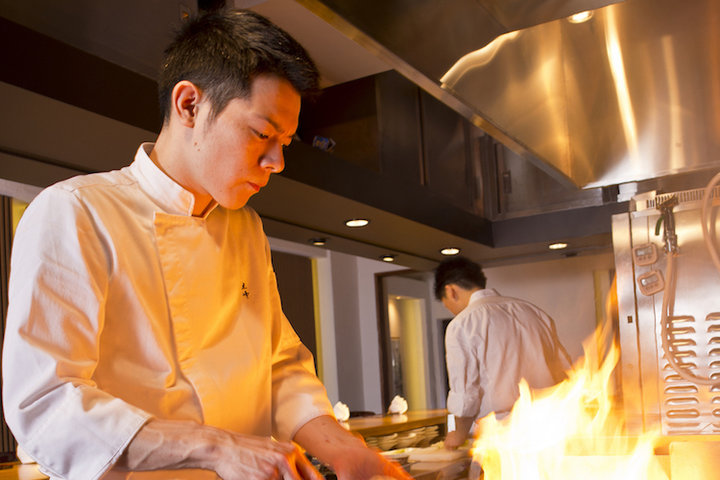
Sichuan, meet Japanese, and by the way, say hello to French; chef Masashi Yamamoto expertly blends the essences of three incredible cuisines, formulating unique Chinese-based concoctions that decorate his elegant counter seating like jewels. Kohou, an anomaly when it comes to Chinese-style, serves a variety of bite-size dishes in succession; to give an idea, the signature chef’s course includes a whopping 25 different servings! Included during November-January are Shanghai Hairy Crab delights, with top-notch Yang-Cheng Lake-breeds steeped in rice-wine a favorite of the kitchen. Guests can request as well steamed crab, another popular option, whilst enjoying a multitude of fine drink pairings, ranging from waters and chinese teas to liquors. Popular as much for its food as for its intriguing and inspiring pairing menu, guests at this unique Chinese restaurant are sure to lost track of time.